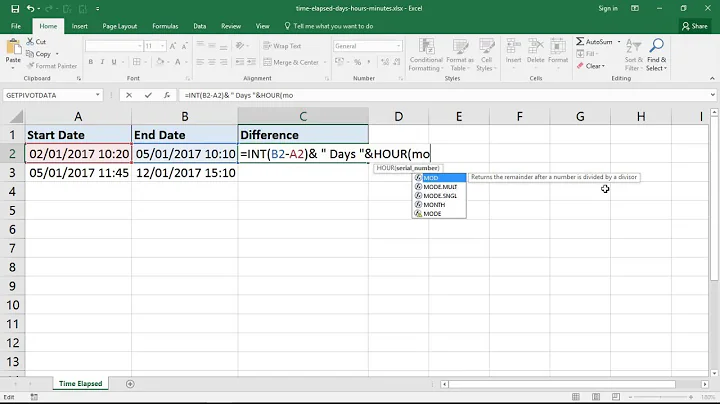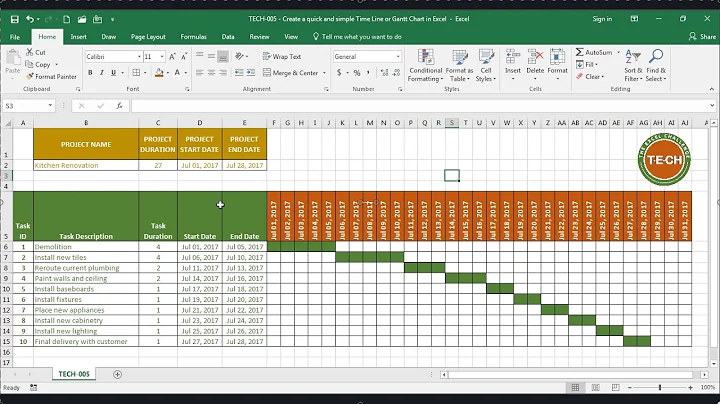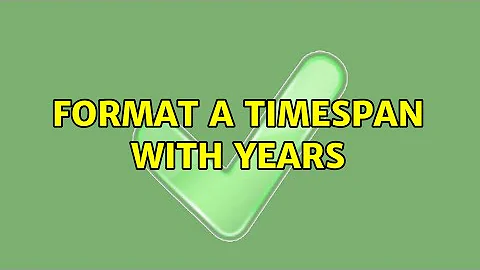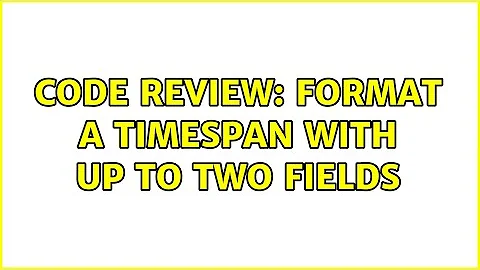Format A TimeSpan With Years
Solution 1
A TimeSpan doesn't have a sensible concept of "years" because it depends on the start and end point. (Months is similar - how many months are there in 29 days? Well, it depends...)
To give a shameless plug, my Noda Time project makes this really simple though:
using System;
using NodaTime;
public class Test
{
static void Main(string[] args)
{
LocalDate start = new LocalDate(2010, 6, 19);
LocalDate end = new LocalDate(2013, 4, 11);
Period period = Period.Between(start, end,
PeriodUnits.Years | PeriodUnits.Days);
Console.WriteLine("Between {0} and {1} are {2} years and {3} days",
start, end, period.Years, period.Days);
}
}
Output:
Between 19 June 2010 and 11 April 2013 are 2 years and 296 days
Solution 2
public string GetAgeText(DateTime birthDate)
{
const double ApproxDaysPerMonth = 30.4375;
const double ApproxDaysPerYear = 365.25;
/*
The above are the average days per month/year over a normal 4 year period
We use these approximations as they are more accurate for the next century or so
After that you may want to switch over to these 400 year approximations
ApproxDaysPerMonth = 30.436875
ApproxDaysPerYear = 365.2425
How to get theese numbers:
The are 365 days in a year, unless it is a leepyear.
Leepyear is every forth year if Year % 4 = 0
unless year % 100 == 1
unless if year % 400 == 0 then it is a leep year.
This gives us 97 leep years in 400 years.
So 400 * 365 + 97 = 146097 days.
146097 / 400 = 365.2425
146097 / 400 / 12 = 30,436875
Due to the nature of the leap year calculation, on this side of the year 2100
you can assume every 4th year is a leap year and use the other approximatiotions
*/
//Calculate the span in days
int iDays = (DateTime.Now - birthDate).Days;
//Calculate years as an integer division
int iYear = (int)(iDays / ApproxDaysPerYear);
//Decrease remaing days
iDays -= (int)(iYear * ApproxDaysPerYear);
//Calculate months as an integer division
int iMonths = (int)(iDays / ApproxDaysPerMonth);
//Decrease remaing days
iDays -= (int)(iMonths * ApproxDaysPerMonth);
//Return the result as an string
return string.Format("{0} years, {1} months, {2} days", iYear, iMonths, iDays);
}
Related videos on Youtube
Comments
-
 Dan almost 4 years
Dan almost 4 yearsI have a class with 2 date properties:
FirstDayandLastDay.LastDayis nullable. I would like to generate a string in the format of"x year(s) y day(s)". If the total years are less than 1, I would like to omit the year section. If the total days are less than 1, I would like to omit the day section. If either years or days are 0, they should say "day/year", rather than "days/years" respectively.Examples:
2.2 years: "2 years 73 days"
1.002738 years: "1 year 1 day"
0.2 years: "73 days"
2 years: "2 years"What I have works, but it is long:
private const decimal DaysInAYear = 365.242M; public string LengthInYearsAndDays { get { var lastDay = this.LastDay ?? DateTime.Today; var lengthValue = lastDay - this.FirstDay; var builder = new StringBuilder(); var totalDays = (decimal)lengthValue.TotalDays; var totalYears = totalDays / DaysInAYear; var years = (int)Math.Floor(totalYears); totalDays -= (years * DaysInAYear); var days = (int)Math.Floor(totalDays); Func<int, string> sIfPlural = value => value > 1 ? "s" : string.Empty; if (years > 0) { builder.AppendFormat( CultureInfo.InvariantCulture, "{0} year{1}", years, sIfPlural(years)); if (days > 0) { builder.Append(" "); } } if (days > 0) { builder.AppendFormat( CultureInfo.InvariantCulture, "{0} day{1}", days, sIfPlural(days)); } var length = builder.ToString(); return length; } }Is there a more concise way of doing this (but still readable)?
-
Kashif about 11 years
-
-
 JDB about 11 yearsThat said, it looks like the OP has settled on a sufficient compromise (for his purposes):
JDB about 11 yearsThat said, it looks like the OP has settled on a sufficient compromise (for his purposes):365.242Mdays per year. -
 JDB about 11 years
JDB about 11 years -
D Stanley about 11 yearsThere aren't 365.242 days in a year. Some years have 365 days, some have 366. There are 365.242 in an average year, which won't work if you're comparing two specific dates. If all that was available was the number of days (which is the bast
TimeSpancan do), then it would be a decent estimate but could be off by one day in certain cases. -
 JDB about 11 yearsI agree with you, I'm just sayin' for a non-public, personal project, precision may (legitimately) take a backseat to convenience.
JDB about 11 yearsI agree with you, I'm just sayin' for a non-public, personal project, precision may (legitimately) take a backseat to convenience. -
D Stanley about 11 yearsHow do we know this isn't being used to calculate the interest on the national debt? :)
-
 Dan about 11 yearsI was actually using this to calculate the interest on the national debt.
Dan about 11 yearsI was actually using this to calculate the interest on the national debt. -
D Stanley about 11 yearsCool! Can you mail me the check for the rounding difference? ;)
-
 JDB about 11 years@DStanley - Still looks like a better estimate then some of the debt interest calculators I've seen. ;)
JDB about 11 years@DStanley - Still looks like a better estimate then some of the debt interest calculators I've seen. ;) -
tofutim about 8 yearsugh, extra third party library - but library by Jon Skeet is pretty convincing.
-
Charlie Fish over 7 yearsWould be good to explain why this code works. Giving more detail is always a good idea when answering questions.
-
 Kana Ki over 7 yearsYou're rendering the month and day here for the conversion to
Kana Ki over 7 yearsYou're rendering the month and day here for the conversion toint, but then dividing by flat ten thousand - casted to an Int. This is almost equivalent to doingdateValue1.Year - dateValue2.yearin terms of accuracy. The result of this would be a single number indicating how years have completely past regardless of any possible 354 trailing days. Semantically, this is also very dubious. -
Thymine almost 5 yearsModified your last line to
return (iYear > 0 ? $"{iYear} years, " : "") + (iMonths > 0 ? $"{iMonths} months, " : "") + (iDays > 0 ? $"{iDays} days" : "").Trim(' ', ',');to cleanup the output. Great simple solution -
Shadowblitz16 over 2 yearsThis doesn't even make sense. years can be calculated by a start and end point. It has nothing to do with it not making sense, it has to do with no support from microsoft. DateTimeOffset could have been used, but they made the minimum constant value to be 0001/01/01 instead of correctly allowing 0000/00/00 so people could calculate differences.
-
Jon Skeet over 2 years@Shadowblitz16: "years can be calculated by a start and end point" - sure, but that's not what TimeSpan represents. And no, I don't think allowing 0000/00/00 would be "correct" or helpful.
-
Shadowblitz16 over 2 years@Jon Skeet I disagree. Its actually helpful when getting a difference between the two dates. If the day, month or year has no difference it would be zero, but C# doesn't allow for that so I have to calculate them separately manually.
-
Jon Skeet over 2 years@Shadowblitz16: No, if you've got two valid dates, you don't need an "extra" date that's completely invalid (which 0000/00/00 is). It's unclear to me exactly what you want to do, but I'd be very surprised if "let's introduce an invalid date into the system" is a useful way of achieving it. (Bear in mind that I've spent a lot of time considering date/time APIs.) If you want to pursue this further, I suggest you ask a new question with more details of what you're really trying to achieve.






![[Modelling 101] 1.2. Formatting the Timeline Bar](https://i.ytimg.com/vi/f2C2i94gJkc/hq720.jpg?sqp=-oaymwEcCNAFEJQDSFXyq4qpAw4IARUAAIhCGAFwAcABBg==&rs=AOn4CLARP0BU3nsod4KgIdJpofPW6SRGBw)


